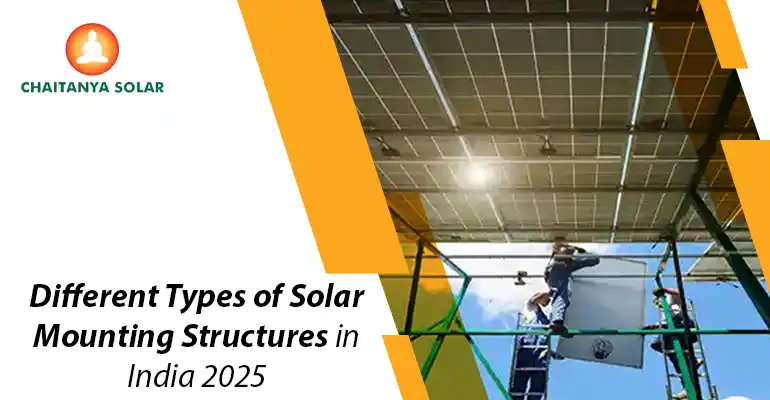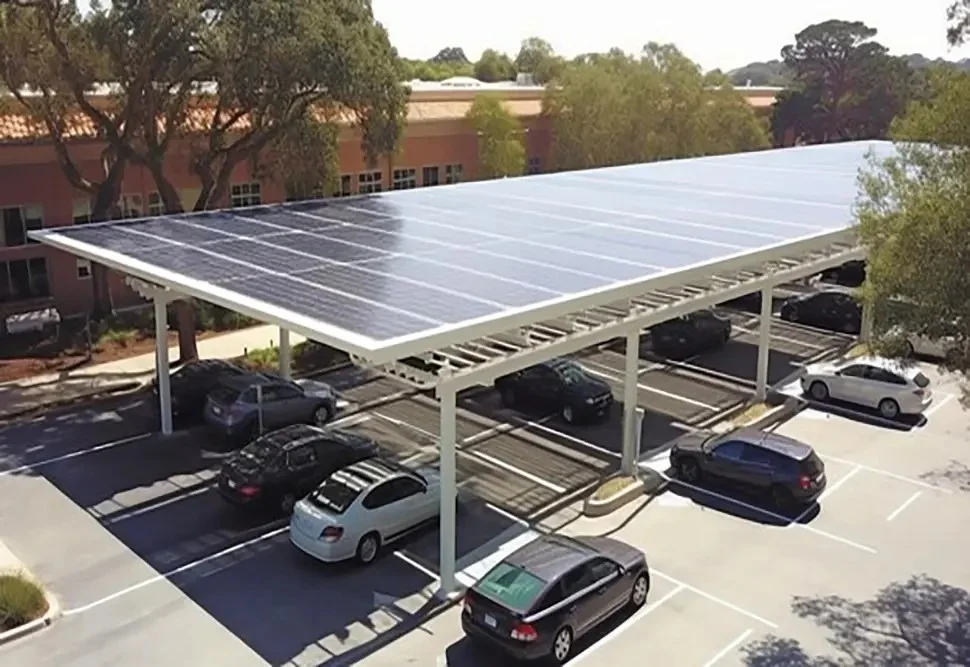Different Types of Solar Mounting Structures in India 2025

Renewable energy industry is growing more and more with the passing years. Solar power has become an important factor that is driving the world towards a sustainable future. And the Solar mounting structure is the most important part of solar power systems.
In this blog, let us understand the design of solar mounting structures in detail.
What is a Solar Mounting Structure?
A solar mounting structure or Solar racking system, is a structure or a framework that is manufactured to provide support to the solar panels or photovoltaic (PV) cells and also keep them secured in optimum position. The main purpose of these structure is to keep the panels in position securely and tilted at the right angle to capture the maximum light. This will lead to the maximum energy production from the sun.
An Overview of Different Types of Mounting Structures
Fixed-Tilt Solar Mounting Structures
Fixed-tilt solar mounting structures are one of the most common and traditional options for solar installations in India. As the name suggests, these structures are set at a fixed angle and orientation to maximize the solar exposure throughout the day.
Being commonly used in utility-scale solar farms and commercial installations, fixed-tilt structures are a cost-effective solution that requires minimal maintenance. Their reliability and simplicity make them a popular choice for solar projects across India.

Solar Tracker Mounting Structures
Solar tracker mounting structures are engineered to track the movement of the sun throughout the day and adjust the panel angles accordingly for maximum energy generation. In India, where sunlight is abundant, these systems are becoming more and more popular for their ability to improve the energy output significantly.
These structures come in two types: single-axis and dual-axis, where the dual-axis trackers offer the highest efficiency. Solar tracker mounting systems are especially advantageous for residential and commercial rooftop installations for maximizing the energy generation.
Ground-Mounted Solar Mounting Structures
Ground-mounted solar structures are typically used for large-scale projects like solar farms and industrial installations. They are designed for direct ground installation and offer stability and easy access for maintenance.
Ground-mounted systems provide flexibility in orientation and tilt which makes them suitable for diverse geographical locations and various solar panel types. Their rugged construction ensures resilience against extreme weather conditions which guarantees a long-term durability.
Rooftop Solar Mounting Structures
Rooftop solar mounting structures are ideal for residential and commercial installations, particularly in urban areas with limited land space. They are designed for rooftop installation and optimize space utilization while offering an effective generation of solar energy.
The densely populated cities in India with high energy demand, rooftop solar mounting structures have become a crucial solution for decentralized power generation. Available in different designs, including fixed-tilt, ballasted, and flush-mounted, they accommodate different rooftop types and structures.
Floating Solar Mounting System
With extensive network of rivers, lakes, and reservoirs in India, floating solar mounting structures have received considerable attention in recent years. These systems are designed to support solar panels on water bodies, which allows for energy production without using the valuable land.
Floating solar mounting structures are both environment friendly and effective in reducing water evaporation in reservoirs. With the abundance of water bodies in India, these installations have the potential to transform the solar energy production in the country.
BIPV (Building-Integrated Photovoltaics)
Building-Integrated Photovoltaics (BIPV) is an innovative approach that combines solar panels into building materials. These systems effortlessly blend with the architecture of a building, serving as both, a power source and structural component.
In India, BIPV is becoming more and more popularity for allowing sustainable and visually appealing solar installations. This innovative approach is perfect for urban areas where space is limited and aesthetics are seen as a priority.
Solar Carport Mounting Structures

Solar carport mounting structures provide shade for vehicles while also generating the electricity. These structures are commonly used in commercial spaces, educational institutions, and parking areas which maximize the land use efficiency.
Solar carport structures provide the double benefit of shielding vehicles from harsh sunlight while also generating the clean energy. With the more and more rise of electric vehicles in India, these structures provide a convenient solution for charging EVs as well as supporting the renewable energy goals of the country.
Ballasted Solar Mounting Structures
Ballasted solar mounting structures are most commonly used for rooftop installations in India. These structures depend upon the weight for support and disregard the need for penetrations in the roof. These structures are versatile, easy to install, and suitable for both flat and pitched rooftops of the building.
Ballasted solar mounting structures are designed to equally distribute weight which helps in maintaining the safety and integrity of the roof. These structures offer a cost-effective solution for rooftop solar installations that is also non-invasive.
Pole-Mounted Solar Mounting Structures
Pole-mounted solar structures are best to be used for locations that have limited space or in a place where ground-mounted installations are not possible. These structures made use of vertical poles to elevate solar panels which maximizes the space efficiency and make sure of optimal sunlight exposure due to advantage of elevation.
Pole-mounted systems are commonly used in agricultural fields, remote areas, and locations with uneven surface. They can be adapted to the height and tilted angle that is required while ensuring the maximum sun exposure.
FAQs – Solar Mounting Structure
What is a mounting structure in a solar power plant?
A mounting structure in a solar power plant is a framework that supports and positions solar panels at the right angle. This is to ensure highest sunlight exposure for maximum energy generation.
How much does a rooftop solar system cost in India?
The cost of a rooftop solar system in India varies depending upon several factors such as system size, quality, and location. On an average, a residential rooftop solar system costs as per required kilowatt (kW).
What are the different types of solar panel mounting structures?
Different types of solar panel mounting structures include fixed-tilt, solar tracker, ground-mounted, rooftop mounts, ballasted mounts, pole-mounted, and in-ground mounts. Each structure is designed to meet distinct installation requirements.
Can a faulty mounting structure affect a solar project?
Yes, a faulty mounting structure can have negative impact a solar project, as it could lead to reduced energy production, structural damage, and safety risks. This makes it important to have a strong, well-designed, and properly maintained mounting system.
How do solar panels mount on a roof?
Solar panels can be mounted on a roof using different methods, such as ballasted systems, rail-based systems, or can be directly attached to the roof beams or rafters. The selection of the mounting method depends upon the type and design of the roof and the need of the owner.
Do solar panels need mounts?
Solar panels usually require mounting or mounting structures to place them securely, maximize exposure to the sunlight and make sure of a long-term performance. In India, the best direction for solar panels is to make them face the south.
Why do solar panels need mounting structures?
Solar panels require that mounting structures to be placed at the right angle and adjusted for maximum sun exposure. This improves the energy production and ensures a long-term stability and superior performance.
What is a ground-mounted solar structure?
A ground-mounted solar system is a solar power installation that are positioned directly on the ground. These structures are commonly used for large-scale projects like solar farms and utility-scale installations. These systems are cost-effective and highly adaptable which allow for an optimal energy capture.
Conclusion
In 2025, the market of India has evolved by leaps and bounds, when it comes to providing innovative solutions for all the solar mounting structures requirements. Solar power industry of India has witnessed a rapid growth, going from traditional fixed-tilt structures to advanced solar tracker systems. These structures not only provide support for solar panels but are also very important for the efficiency, sustainability, and aesthetics of solar installations.
Get in touch with Chaitanya Solar, if you want a head start in your sustainable investment journey. For the top consultation in India and harnessing the power of solar resources while meeting your clean goals, contact them now!
Enquiry Form



